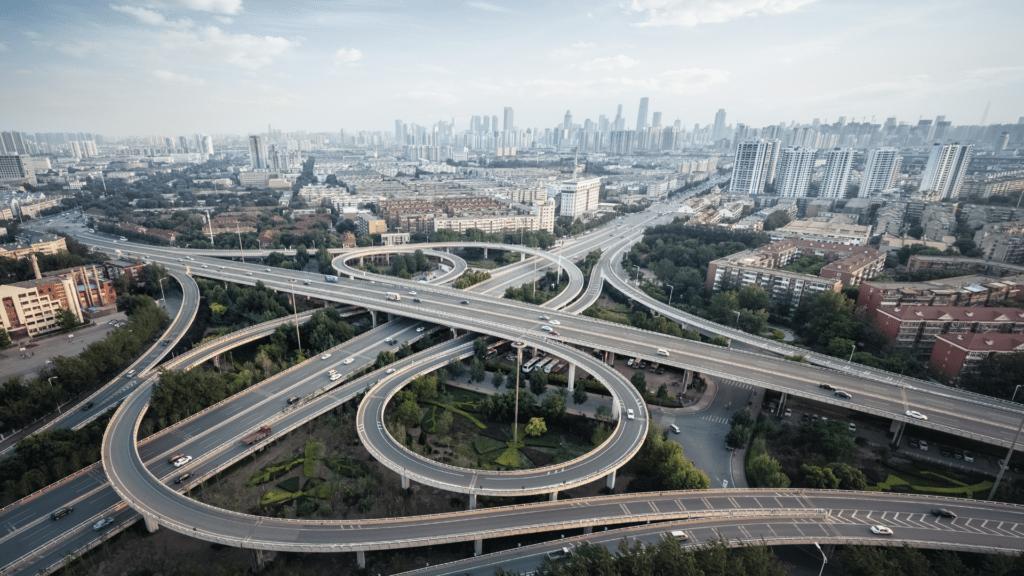30 September 2023 In Asia, Blog Post, Public Transport, Sustainable Development
Breaking the Lock-In Effect of Car-Centric Systems through Integrated Transport Planning
By Zhi Liu, Senior Research Fellow and China Program Director, Lincoln Institute of Land Policy, and Director, Peking University—Lincoln Institute Center for Urban Development and Land Policy
Integrated transport planning has been practised in many countries and regions around the world for decades, connecting different transport modes to optimise the moving of people and goods in a resource-efficient manner. A transport system is a complex, comprising different modes such as road, rail, air, and water transport. They perform differently and generate different levels of emissions during construction and operations. For example, motorised vehicles powered by fossil fuels emit more carbon dioxide (CO2) per passenger-kilometre than rail transport powered by electricity. Therefore, it is important to understand the CO2 implications of different modes when planning an integrated transport system. Moreover, transport infrastructure is expensive to build and once constructed, it will last for many years. If found undesirable, undoing the infrastructure incurs significant costs, causes disruption to transport services and imposes further negative impacts to the environment and the livelihoods of local residents. Many automotive-centric transport systems are stuck in such a lock-in effect. Integrated transport planning would take modal emission information into consideration, identify and plan optimal multi-modal transport systems that are not just economically efficient but also people-centric and environmentally sustainable.
The Path to Zero: A Vision for Decarbonized Transport in Asia: Overcoming Blind Spots and Enabling Change, a report by the Council for Decarbonizing Transport in Asia, calls for various actions to support the transformation to a zero-carbon transport system. Integrated transport planning, one of the recommended immediate actions, will play a crucial role in the sector’s path to a zero-carbon future, whilst the lack of integrated planning will lead to patchwork systems that waste the potential of efficient transformation.
For decades, transport planning in China at the national, provincial and municipal levels focused mainly on building transport systems that would serve the economy efficiently. These plans were not always effective as different transport modes were planned and managed by different line agencies, which caused a lot of operational and performance issues and did not contribute to enhancing system efficiency. Seamless and integrated transport systems were only becoming possible after China initiated institutional reorganisation that unified all transport modes under the same transport agency in 2008.
Around the same time, China’s ambition for sustainable, low carbon transport development has grown with a particular focus on public transport. With a grant from the Global Environmental Fund and technical support from the World Bank, the Ministry of Transport developed an Integrated Ecological Transport Planning Guideline in 2016 for city clusters to transform their transport and mobility systems. The guideline was published in 2016.
City clusters are a form of urban concentration in China. A city cluster comprises two or more geographically adjacent cities linked by commuting corridors with increasing social and economic interdependence. It is similar to a large metropolitan area, but it contains sizable rural areas in the Chinese context. With rapid urbanisation, city clusters are growing rapidly and are becoming the engines of China’s national economic growth.
The guideline aims to “meet the future development of city clusters in a balanced way by allocating transport resources through quantitative analysis whilst promoting comprehensive, green, safe, and smart transport, by integrating transport subsystems of the city cluster rationally and building a sustainable eco-transport system of the city cluster”. While the scope of the guideline is for city clusters, the principles can be applied to other geographical areas.

Beijing-Tianjin-Hebei City Cluster, one of the biggest city clusters, has a population of 11 million and an area of 216,000 square kilometres. An integrated transport planning study was conducted in 2013. The study projected the transport CO2 emissions under alternative travel demand scenarios and alternative transport systems. By incorporating the quantification of CO2 emissions into the planning process, the study identified options to optimise the cluster’s transport network and to reduce CO2 emissions by reducing redundant travels and road vehicle travels. These options included the development of rail-based public transport infrastructure and strategic transport hubs to facilitate easy transfers, as well as adjustment and optimisation of freight logistic routes.
In 2020, China announced its goal to achieve carbon peak by 2030 and carbon net-zero by 2060. Reducing transport CO2 emissions was one of its main focuses. Its key actions include:
- Facilitating modal shifts from road to rail and from road to water
- Speeding up multimodal transport development
- Scaling up single-ticket systems for multimodal transport services,
- Developing public transit-based cities
- Financing green freight demonstration projects
- Promoting green roads, green ports and green waterways, among others.
While the impacts on CO2 emission reduction of these actions are yet to be measured, it is encouraging that the ball is rolling towards the right direction.
As decision makers and policy drivers meet at the United Nations Climate Change Conference in Dubai (COP28) this year, we need to let them hear China’s success stories in overcoming the lock-in, automobile-centric transport systems with a new paradigm for integrated transport planning. The practice does far more than decarbonisation. Creating more seamless and integrated systems through the “Avoid-Shift-Improve” framework also helps to avoid unnecessary motorised trips, shift to sustainable, low carbon modes and improve transport energy efficiency. A balanced, people- and planet-centred approach for planning can create transport and mobility systems that truly foster social equity, economic growth without harming the environment.

Zhi Liu
Dr. Zhi Liu is Director of Peking University – Lincoln Institute Center for Urban Development and Land Policy, and Senior Research Fellow and China and Asia Program Director of the Lincoln Institute of Land Policy. He specializes in infrastructure policy, city planning, municipal finance, and land policy. Previously, Mr. Liu was Lead Infrastructure Specialist at the World Bank, with operational experiences in the infrastructure and urban sectors in a number of developing countries. He holds a Ph.D. in Urban Planning from Harvard University.